If you have decided to get a Rottie as a new family addition; congrats! They are lovely, lively pups that guarantee to bring joy to your household.
However, if you are conflicted about purchasing a German or American Rottie, there is no need to be. You’ll be surprised to find that they do not have as many differences as you’d expect.
German Rottweilers have undocked tails, whereas American Rottweilers have docked tails. German Rottweilers are more robust and have broader bodies. German Rottweilers are more expensive and have to undergo a breed suitability test. American Rottweilers have a more comprehensive range of coat colors.
The truth is, all purebred Rotties come from a German descent.
For that reason, German Rotties and American Rotties have subtle differences that aren’t at all prominent. But, if you are interested in knowing the finer detail, continue reading.
Click Here to Jump to a Section
How Can I Tell if a Rottweiler is a German or American Breed?
Other than the Rottweiler’s certification stating where it was born, you can tell if the Rottweiler is a German or American breed based on its physical features.
German Rottweilers tend to be slightly taller with a more muscular build than the American Rottweiler.
Continue reading for detailed overview of differences.
German Rottweiler
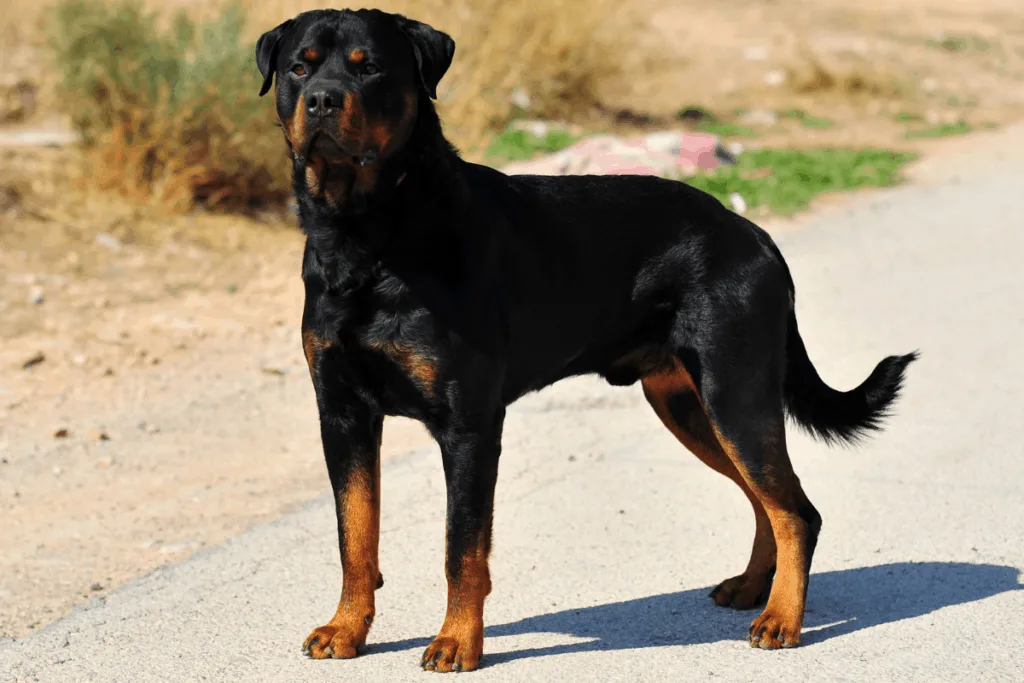
German Rottweilers are recognized as unfaulty, original, and certified Rottweilers and are believed to be the preserved versions of the old herding and driving canines.
Breeding Standards
Germany has stringent and rigorous set standards to certify whether a Rottweiler is German.
If the same breed has been altered or bred in another country, the Rottweiler would not be recognized as a German Rottweiler.
In Germany, breeders have to do a breed suitability test to evaluate whether the Rottweiler is in accordance with the official breed standards.
Breeders are not allowed to register the puppies if their parents have failed the breed suitability test.
Physical Traits
German Rottweilers have broader bodies and tend to look more impressive than most American Rottweilers due to German Rottweilers strictly being bred by the standards of ancient Rottweilers.
Here’s a comprehensive description of how they look:
- Head: German Rotties have wide and more menacing heads that are broad between their ears. The German Rottweiler’s forehead line is moderately arched when viewed at a side profile.
- Eyes: German Rotties have almond-shaped eyes that are dark brown. Their eyes are neither receding or protruding, similar to the American Rottie.
- Ears: They have high-set triangular ears that drop to the same level as their skull when alert, similar to the American Rottweiler.
- Nose: German Rotties have broad noses with relatively large nostrils. Their noses are black.
- Neck: They have moderately long and well-muscled necks, without excessive dewlaps (loose skins hanging from the neck).
- Body: German Rottweilers have slightly broader and more muscular bodies than American Rottweilers. German Rotties have solid fore chests and well-sprung ribs.
- Tail: German Rotties always have natural, undocked tails. Tail docking is not at all allowed for German Rottweilers.
- Coat: German Rotties have a top-and-undercoat, similar to American Rotties. Their undercoat is entirely hidden, and their topcoats are medium-length, dense, and straight. Their coats range in three primary colors: black and mahogany, black and rust, and black and tan.
Black and Mahogany German Rottweiler
Black and Mahogany German Rottweilers have a black coat with medium-saturated, reddish-brown markings. Black and Mahogany German Rotties look the same as Black and Mahogany American Rotties.
Black and Rust German Rottweiler
Black and Rust German Rottweilers primarily have black coats with various accents of rusty, brownish-red markings.
Black and Tan German Rottweiler
Black and Tan German Rottweilers have a primarily rich black coat with several tan markings that do not exceed over ten percent of their coat color.
Height and Weight of a German Rottweiler
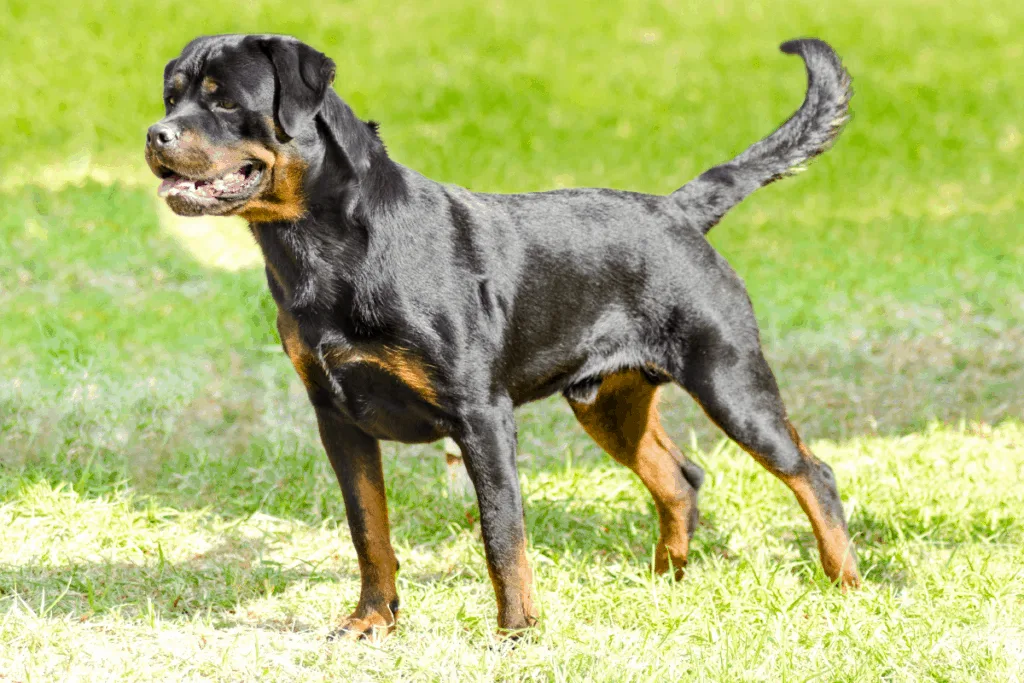
German Rottweilers are medium-large breed canines. Female Rottweilers are slightly smaller than males.
Height and Weight of Male German Rottweiler:
- Height: Approximately 24 to 27 inches
- Weight: Approximately 110 pounds
Height and Weight of Female German Rottweiler:
- Height: 22 to 25 inches
- Weight: Approximately 93 pounds
German RottweilerTemperament
- Good-natured
- Placid
- Devoted
- Eager to work
- Obedient
- Biddable
- Fearless
American Rottweiler
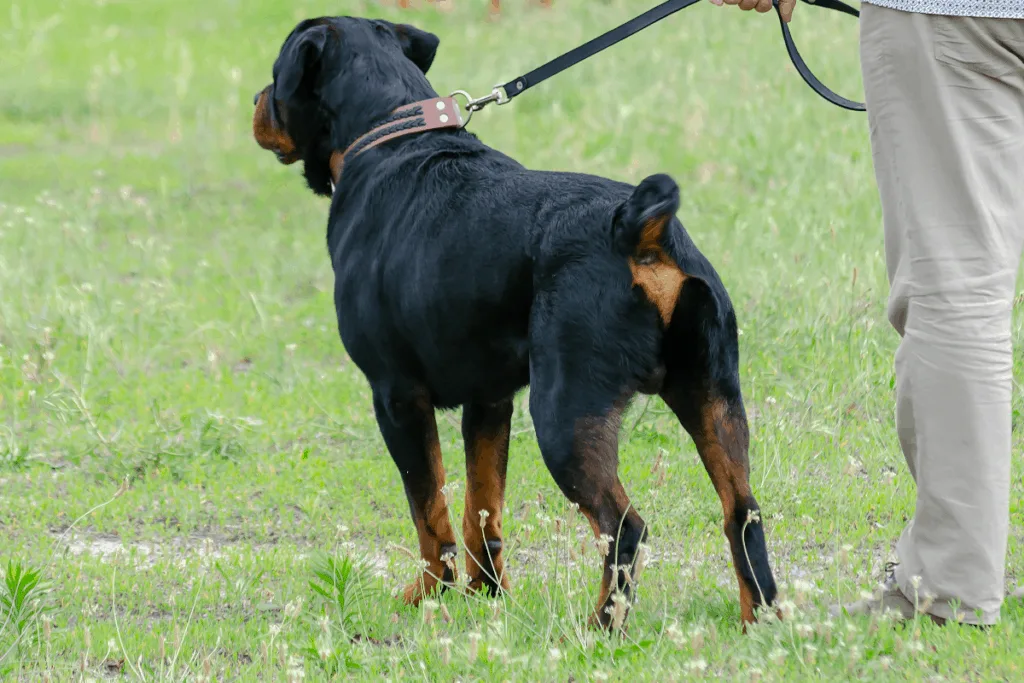
American Rottweilers are a variation of the original German Rottweiler breed.
They were labeled as American due to their deviated standards set by the ADRK (the worldwide governing body for Rottweilers).
Breeding Standards
Unlike Germany, the United States permits breeders to register and sell puppies as purebreds, regardless of the parents being faulty Rottweilers.
Subsequently, American Rottweilers come in numerous variations.
Physical Traits
American Rottweilers are generally robust canines that are medium-large in size.
American Rotties are also slightly taller and leggier than German Rotties.
Here’s a comprehensive description of how they look:
- Head: American Rotties have medium-length heads that appear broad between their ears. Their heads are relatively smaller than German Rotties.
- Eyes: American Rotties have almond-shaped eyes that are dark brown. Their eyes are neither receding or protruding.
- Ears: They have triangular ears that drop to the same level as their skull when alert.
- Nose: Broad, rounded nose that’s black.
- Neck: American Rotties have moderately long and well-muscled necks that are slightly arched. They do not have loose skin around their necks.
- Body: They have deep and broad chests, with a well-pronounced fore chest.
- Tail: Usually docked.
- Coat: American Rotties have an undercoat around their necks and thighs and a dense and straight outercoat, ranging in three standard colors: Black and mahogany, black and rust, and black and tan. However, other color variations of blue, red, and all-black also exist.
Black and Mahogany American Rottweiler
Black and Mahogany American Rottweilers have deep black coats with markings described as dull, reddish-brown.
Some Rotties have medium-saturated coloring, while others tend to have more affluent markings.
Black and Rust American Rottweiler
Black and Rust American Rottweilers have a typical black coat and reddish-brown markings that the described as medium-brilliant.
Black and Tan American Rottweiler
Black and tan American Rottweilers have similar appearances to the black and rust Rottweiler.
But if you closely compare the two, you’ll notice that black and tan Rottweilers’ markings are paler and a bit yellowish in color.
Blue American Rottweiler
Blue American Rottweilers are pretty scarce. They have silvery grey coats instead of the distinct black coat that most Rottweilers possess.
However, they also have markings that range from mahogany to tan.
Black American Rottweiler
Solid black Rottweilers are also a rare variety.
They don’t have any distinct markings on their body, but their tan or lighter color undertone is noticeable in daylight.
Red American Rottweiler
The AKC does not recognize the Red American Rottweilers as true Rottweilers, but they do exist.
Red American Rottweilers have a black coat with reddish marking that looks almost tan in sunlight.
Height and Weight of an American Rottweiler
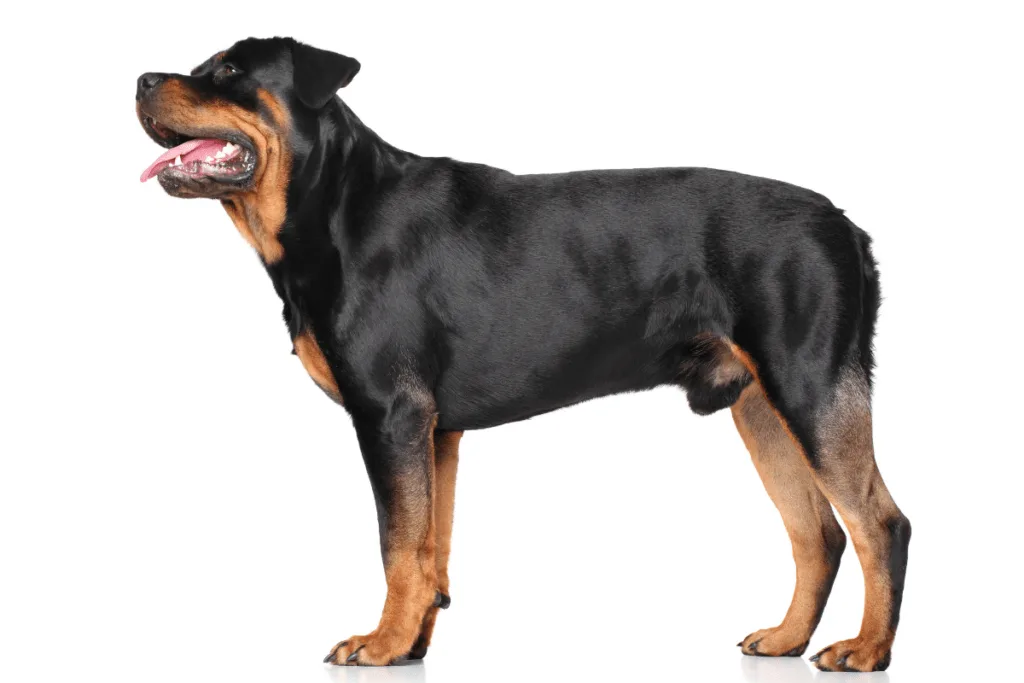
Like German Rottweilers, American Rottweilers are medium-large breed canines, and the female Rottweilers are slightly smaller than the males.
Height and Weight of Male American Rottweiler:
- Height: 24 to 27 inches
- Weight: 95 to 135 pounds
Height and Weight of Female American Rottweiler:
- Height: 22 to 25 inches
- Weight: 80 to 100 pounds
American Rottweiler Temperament
- Loving
- Loyal
- Confident guardian
- Gentle playmate
- Self-assured
- Aloof
- Placid
German and American Rottweiler Life Span
Both German and American Rottweilers have a lifespan of approximately 9 to 10 years.
Unfortunately, both bloodlines tend to develop health complications that prevent them from living as long as most other breeds.
However, several pet owners have reported that their Rotties have lived beyond ten years.
Health Problems of German and American Rottweilers
German and American Rotties are prone to similar health complications.
Be sure to monitor your Rottie and to take them to the vet if any of the following common disease symptoms occur:
- Cataracts: This is one of the common health problems Rottweilers get. Opacity in your Rottweiler’s eyes may cause cataracts.
Cataracts have various stages, including incipient, immature, mature, and hyper mature (completely clouded eyes and shriveled lenses). Fortunately, cataracts can be corrected with surgery. - Progressive Retinal Atrophy: Rotties are unfortunately prone to progressive retinal atrophy. This condition occurs when the dog’s photoreceptors found in the back of their eye begin to fail.
Progressive retinal atrophy initially affects the dog’s night vision but later affects its daylight vision as well, and it may even cause total blindness.
Progressive retinal atrophy, unfortunately, cannot be cured.
- Hip Dysplasia: This health issue often affects most heavier set canines, not only Rottweilers.
Hip dysplasia is a displacement between the hip joints and thighbone, which causes a decrease in mobility and hip strength.
Other symptoms include abnormal gait, extreme tenderness, pain while walking, lameness, fragility, and in worst cases, immobility.
Hip dysplasia can be treated through lifestyle modifications or surgery.
- Elbow Dysplasia: Elbow dysplasia is a displacement between the joint and bone.
Elbow dysplasia has similar symptoms to hip dysplasia, including abnormal gait, extreme pain, lameness, difficulty in straightening their arm, and immobility in the worst cases.
Surgeries are mostly successful, allowing your Rottie to live a healthy, pain-free life.
- Aortic Stenosis: A heart disease that occurs when there is an obstruction or partial difficulty in the blood flow to the dog’s heart.
Due to the block, the Rotties heart has to work twice as hard to keep him healthy, ultimately leading to organ exhaustion.
If not identified early, aortic stenosis may lead to a heart attack.
- Cancer: Cancer is one of the most common causes of death for Rottweilers. The most common kind of cancer in Rotties is lymphoma, but liver, spleen, and bone cancer are also relatively common.
The causes of cancer in dogs have unfortunately not yet been discovered; however, constantly examining your Rottie tumors can be detected early and treated.
- Osteochondritis Dessicans: This is an unusual growth of cartilage on the end of a bone in the dogs, which causes the diseased cartilage to separate from the underlying bone.
Due to Rottweiler’s fast-growing and large bones, they are more prone to osteochondritis. Their fast-growing bones do not always align properly, leading to similar symptoms as hip and elbow dysplasia, but dislodging or broken bones can
Osteochondritis typically occurs between 6 and 9 months of age and is luckily treatable with surgery.
- Allergies: Rotties common allergies include food allergies, inhalant allergies, and skin allergies. Rotties also have thick undercoats where bacteria and fleas tend to accumulate. The bacteria may cause allergies and often eczema.
Is There a Difference Between a German and American Rottweiler’s Temperament?
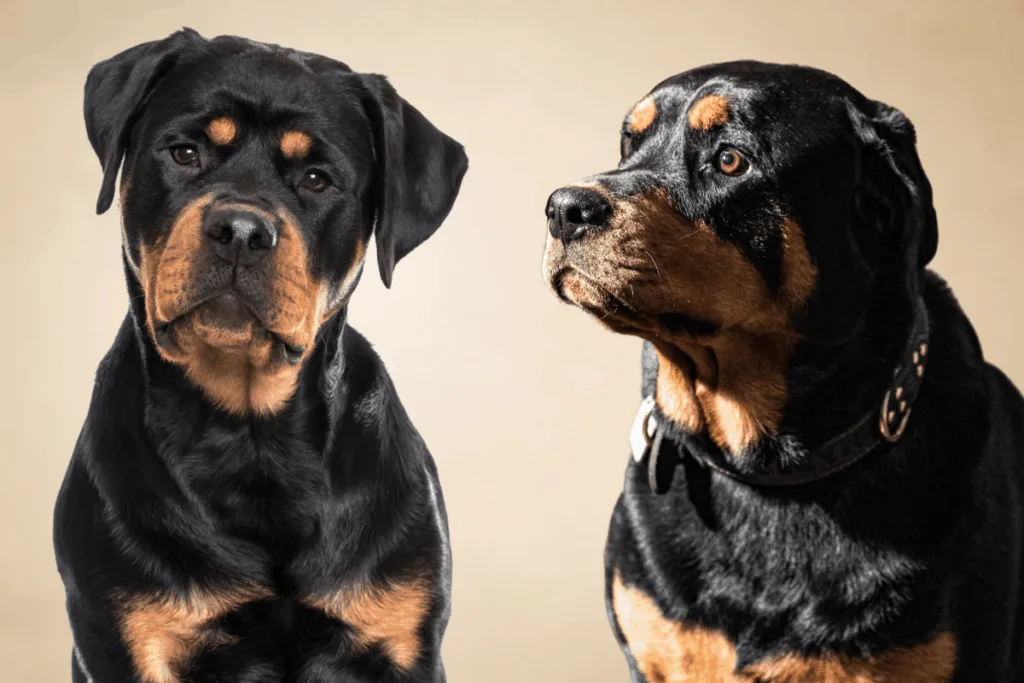
Due to the German and American Rottweiler originating from the same breed, their temperament isn’t too different.
However, a German Rottweiler breed is strictly bred to assist their human companions. They are assured to be sharp-minded and calm. German Rottweilers are used as guide dogs, security dogs, or family dogs.
After all, both breeds are highly trainable, loyal, and protective of their owners, making wonderful pets.
Despite Rotties having a reputation of being aggressive, the statement should mostly apply to Rottweilers that weren’t taken well care of by their owners. With the proper care and circumstances, your Rottweiler should be a pleasant addition to the family.
The following factors play a significant role in their personality and temperament:
- Social Exposure: Rotties exposed to proper socialization and given endless love and care from an early age, is sure to develop a forbearing and gentle temperament.
- Dependency: Rottweilers come forth as strong and confident dogs, but they tend to have a very needy side to them.
They may be overly dependent on their owners. If you’re the type of owner who doesn’t have much time to spend with your dog, then owning a Rottweiler might not be the best choice for you. - Hands-on owner: In addition to the previous statement, Rottweilers need owners who can provide a lot of attention and owners willing to train them to become obedient and helpful dogs.
Rottweilers tend to develop mental and emotional issues if not given enough attention, ultimately affecting their quality of life.
German and American Rottweiler’s temperament greatly depends on how they were trained and socialized by their owners. First, however, let’s still look at the expected behavior of these two canines.
German Rottweiler
German Rottweilers are robust dogs, but they can become family companions if they are well-trained and exposed to socialization.
German Rotties need a lot of stimulation and exercise. If you aren’t up for long walks and playing outdoors with your dog, you should consider getting a different dog.
Trainability
German Rottweilers are brilliant and obedient dogs that are easy to train. The key to properly raising Rotties is to expose them to basic training classes and socialization early.
Ensure that you are firm with them, but without being mean, as it’ll only encourage aggressive behavior.
A small tip: They respond well to treats.
With Children
German Rottweilers are usually good with kids.
They aren’t more dangerous around kids than other dog breeds; however, they are slightly more dangerous than American Rotties.
However, if your German Rottie is well-trained, it’ll be an excellent protector and playmate for your children.
Related: Are Rottweilers Good With Kids? Yes! And Here’s Why
With Strangers
German Rottweilers tend to be distant and aloof with strangers; they tend to have a serene disposition.
German Rotties do not immediately get along with strangers, but they aren’t too aggressive with them.
German Rottweiler’s nature is to guard and protect; they show exemplary alertness in front of strangers.
With Other Dogs and Pets
German Rottweilers have sharp personalities; they are dominant and want to prove that they are the alpha.
Therefore, you should not expect them to interact calmly or well with other canines, especially dogs of the same gender.
American Rottweiler
American Rottweilers are great family dogs! However, if you are new and inexperienced in owning dogs, we would not encourage you to start with a Rottie.
American Rotties need a lot of socialization and require intense training for them to be gentle companions.
American Rotties tend to develop separation anxiety once closely attached to humans.
Therefore, if you cannot spend a lot of time with them and do not want to take on the responsibility, opt for a different dog.
Trainability
American Rotties are intelligent canines that are highly trainable.
American Rotties love to please their owners; however, they tend to be a bit stubborn. The key to raising Rotties well is early socialization and engagement in basic training classes.
Be firm with them without being impudent or mean, like the German Rottweilers; it will only encourage unwanted aggressive behavior.
With Children
American Rottweilers tend to have a good relationship with children if they are trained appropriately.
While American Rotties love to play with kids, adult supervision is always advised.
With Strangers
Strangers tend to find American Rottweilers distant and unapproachable due to their “wait-and-see” attitude.
American Rottweilers are skeptical canines and do not get along with strangers immediately.
American Rottweilers might be mistaken as shy and standoffish. The is because they first assess whether the strangers are a threat or not.
With Other Dogs and Pets
American Rottweilers are not as dominant as German Rottweilers.
They don’t have problems with other animals as long as they are raised alongside them. However, similar to German Rotties, American Rotties may react violently with dogs of the same gender.
To summarize, whether owning a German or American Rottweiler, there’s no doubt they’ll be the best companions if they’re raised in a dog-loving home.
German and American Rottweiler Working Skills
Rottweilers are primarily bred to be drovers or herders. It is essential to look at their working skills to choose the right fit for your family and needs.
Related: Are Rottweilers Good Farm Dogs?
German Rottie: They are excellent workers primarily bred to be herders, drovers, and protectors.
American Rottie: They have deviated from the original, purebred agility of the German Rottie, but they are still excellent protectors and working dogs.
German and American Gait or Movement Differences
Gait is the quality of the canine’s movement.
Therefore, a great deal of importance is given to their gait; it is believed to reflect the dog’s overall skills.
German Rottweiler
German Rottweilers are described to have balanced, powerful, and harmonious trotting movements.
German Rottweilers have stable backs, and every move is ground-covering and firm. Their gaits are further described as unrestricted and full of energy.
American Rottweiler
American Rottweilers are known as trotters. They have a similar movement to German Rotties-balanced, powerful, and harmonious.
American Rottweilers have a strong forereach and rear-drive, and their motion is ground-covering and effortless.
Is a German or American Rottweiler More Expensive, and How Much do They Cost?
German Rottweilers are usually more expensive than American Rottweilers to purchase; however, their maintenance costs are similar.
Expect to spend money on their training, insurance, and other primary needs such as injections, deworming, and quality food.
German Rottweilers are more expensive than American Rottweilers because of their more rigorous breeding. They usually cost around $2,700 to $3,000.
American Rottweilers cost approximately $1,500 to $2,500. However, this is only the initial purchasing price of the dog.
A Summary of German vs. American Rottie Differences
| GERMAN ROTTWEILER | AMERICAN ROTTWEILER | |
| 1. | Original, unfaulty, preserved version of Rottweilers | A variation of the original German Rottweiler breed |
| 2. | Have to undergo strict breeding suitability tests | Deviated standards |
| 3. | Natural, undocked tails | Docked tails |
| 4. | Broader and more menacing heads | Medium-length heads, relatively smaller than the German Rottie |
| 5. | Broader bodies and tend to look more impressive | Slightly taller and leggier than the German Rottie |
| 6. | More muscular bodies | Less muscular bodies |
| 7. | Three color variations: Black and MahoganyBlack and RustBlack and Tan | Six color variations: and mahogany Black and Rust Black and Tanred American Blue Solid black |
| 8. | Health certified | Not necessarily health certified |
| 9. | More dangerous around kids | More child-friendly |
| 10. | Dominant and does not get along well with other pets | Fine with pets that they were raised alongside but may be aggressive to canines of the same gender |
| 11. | Appropriate for hard-working dogs (herder, protector, and drover) | Suited as a family protector and companion |
| 12. | More expensive ($2,700 to $3,000) | Less expensive ($1,500 to $2,500) |
Which Rottie is Right for You?
German and American Rotties have many similarities.
If you are still torn between the two, have a look at this summary to help you make up your mind.
The German Rottweiler is best suitable for you if:
- You want to ensure that your Rottie is purebred originating from ancient bloodlines.
- You prefer purchasing a health-certified dog.
- You are after an excellent, hard-working work dog.
- You prefer a stockier and more powerful canine.
- You don’t mind owning a pup with limited color options.
- You are comfortable spending approximately $2,700 to $3,000, excluding shipping costs.
The American Rottweiler is best suitable for you if:
- You are looking for a large companion and family protector.
- You prefer your dog leaner and leggier.
- You want Rotties with a broader variety of colors like blue, red, and all-black coat colors.
- You prefer owning a Rottweiler with a docked tail.
- Your budget is between $1,500 to $2,500.
Be sure to watch the video below for an excellent discussion about the difference between these two kinds of Rottweilers!
Final Thoughts
German Rottweilers have stringent breeding standards to ensure broad-shaped heads and muscular bodies with an intelligent, herding, and protective nature.
On the contrary, American Rottweilers may not wholly comply with the set standards, but they have very similar appearances and traits and are far more suited for companionship.
The truth is, as a casual pet owner, there is no wrong choice in choosing either a German or American Rottie.
If you can give the pup a lot of love, attention, and proper training, choose whichever best suits your budget and needs.
